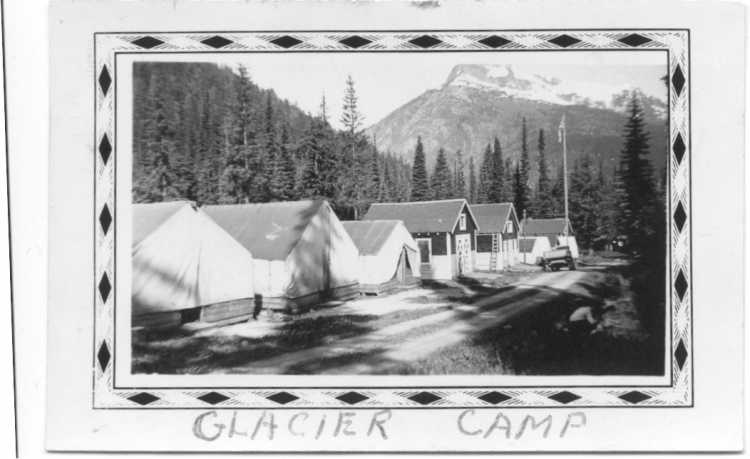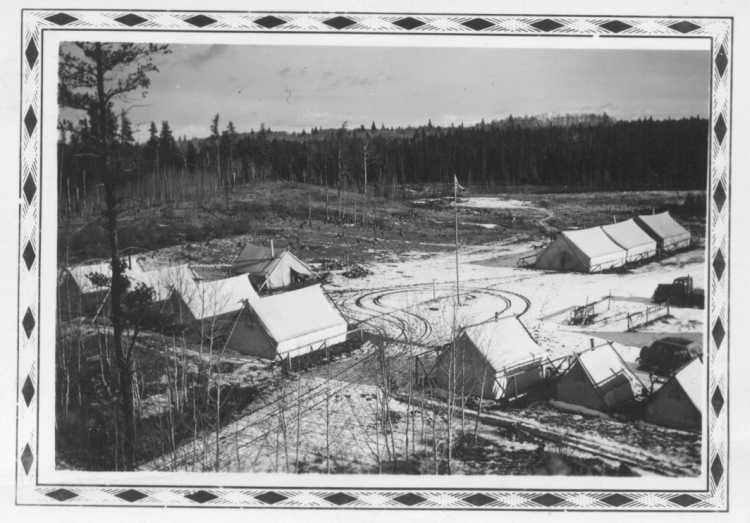Page
1 | Page 2 | Page
3 | Page 4 | Page
5 | Page 6 | Back
to Life at Camp Page
If
you've been camping before, you know something about what the COs
experienced. The rain, the bugs, the dirtiness. The one difference
is that instead of relaxing, the COs had to work every day. Living
conditions varied in each camp. In Manitoba, where the winters are
very cold, the cabins had to be warm enough for the men. In some
summer camps in BC, the men slept in tents. To give you an idea
about camp life, let's look at housing and food, as well as some
free time activities like laundry and haircuts.
Housing
The
Manual of Instruction
had a blueprint of the suggested camp layout, but each camp
adapted that plan. Each camp had a kitchen, a dining room, tents
or cabins for sleeping, and an outhouse for the bathroom.

S.D.
Ramer served in Castle Mountain Camp.
“The
dining room with a kitchen at one end, was large enough to accommodate
forty or more people. Eight or ten tents were to be our living
quarters. A tent had a plank floor, walls four feet [1.2 m] high,
and rafters covered with canvas. Forty gallon [151 L] drums were
converted into heaters to heat the tents. One tent was the bath
house where we washed and bathed.” [ASM, 201]
Abram
L. Ens describes the buildings at the camp near Kootenay, BC.
“The
buildings were of rough lumber construction, with tar paper and
lath exterior. The inside was not boarded. We had open ceilings,
a forty-five gallon barrel on its side for a heater, with a cut
off barrel on top of the heater for our hot water supply. In one
corner there was a sink for washing. The rest of the bunkhouse
was taken up with one-man cots, mattresses and gray woolen blankets.
On the inside of the door, the rules and regulations to be adhered
to, were posted.” [ASM, 229-231]
In
Clear Lake, Manitoba, Erwin R. Giesbrecht reports that COs had to
stuff their own
mattresses.
“The
camp was about six miles [10 km] north of the town of Wasagaming.
The tents had wooden floors and were all set up with bare army
cots. We were given a big bag and some hay to fill our mattresses
with. The tents and cots were all the same so there was not much
choosing.” [ASM , 75-93]
 |
 |
| Glacier CO camp |
CO tents at Riding Mountain National Park |
Jake
Krueger also worked at Clear Lake. He expands on Giesbrecht's comments
on the mattresses.
“As
we jumped from the truck we were directed like cattle into a new,
well-lit bunkhouse, where 24 steel cots stood military fashion
along three walls waiting to be claimed…. We were each handed
four rough army blankets and a large burlap sack, and advised
to fill it full of hay in the horse barn, -- our mattress for
the duration. Reluctantly and with foreboding we complied, and
filled our sacks.”
“Naturally,
everybody wanted a soft mattress – so thinking more hay meant
softer sleeping, we all over-filled our sacks, to the consternation
of all of us, as one after the other we rolled off our round mounds
and bounced on the floor all night long. Nobody slept what was
left of the night anyway. It took a while getting used to our
early model “Sertas”, but after a few nights we had them flattened
out enough to stay put all night – and those people who had not
brought pillows, slept on their ears.” [ASM, 236]
Peter
A. Thiessen had a similar experience in Riding Mountain National
Park.
“There
was somebody to give us directions to the time keeper's office,
also a tent. There we gave our names and where we came from. He
gave us a long bag and we were told to which tent to go to with
the baggage. That was our home for the next four months. Then
we were directed to a pile of straw to fill the bag for our mattress.
On each bed was a cotton bat pillow, that soon got hard. Trying
to fluff it up made it feel like a bag of dead rats. But we made
it for the next four months.” [ASM, 15-17]
Page
1 | Page 2 | Page
3 | Page 4 | Page
5 | Page 6 | Back
to Life at Camp Page |


